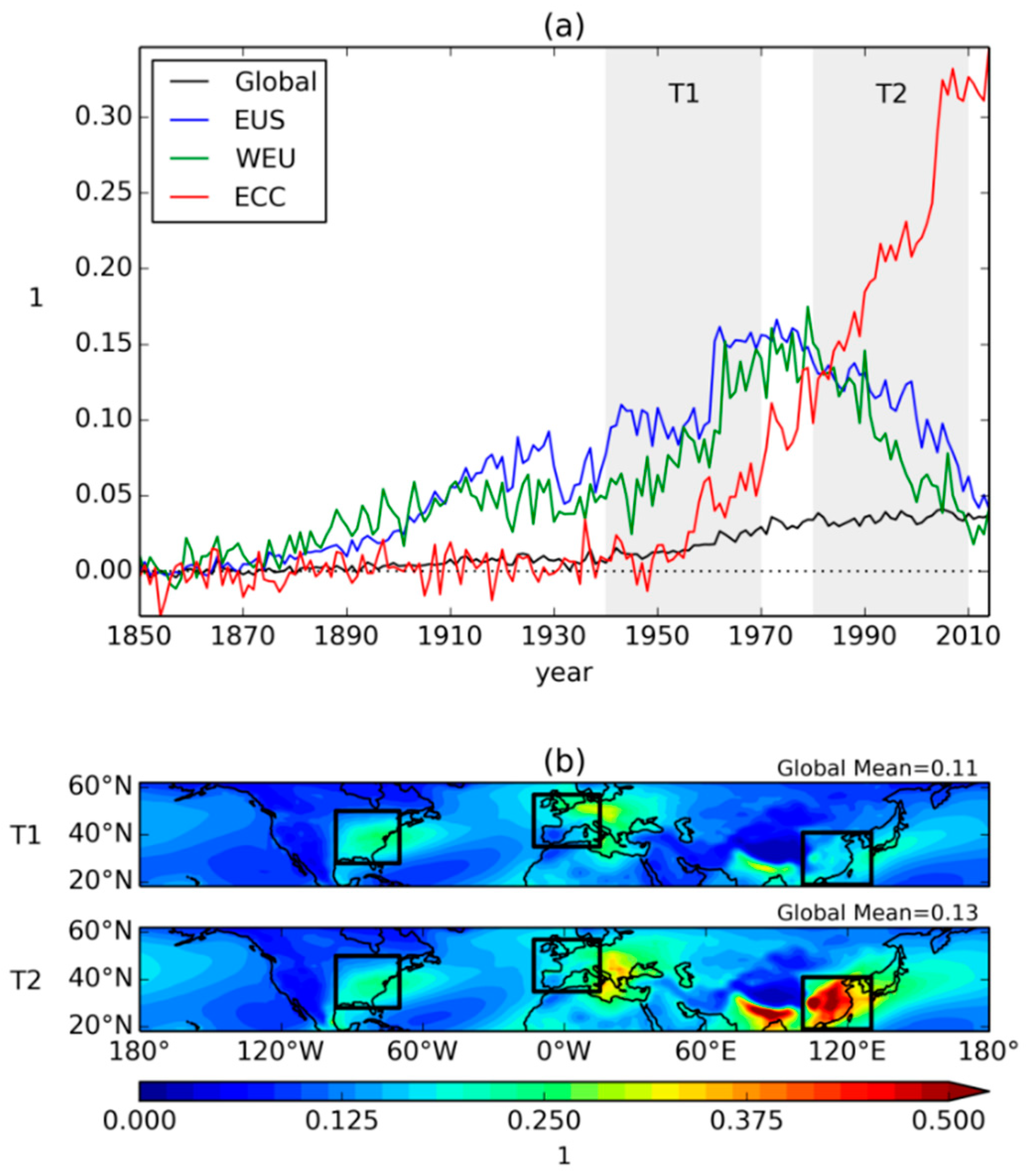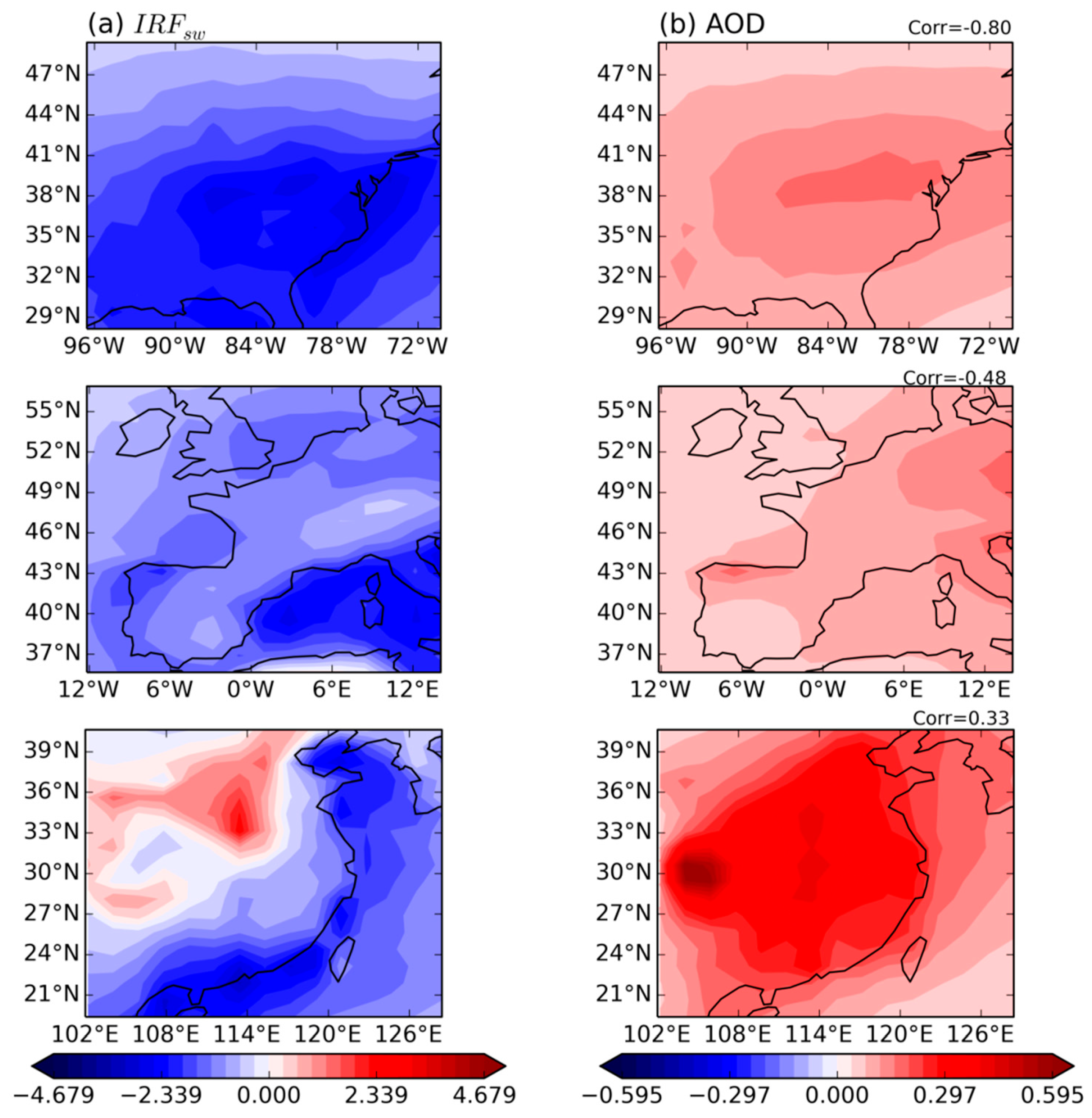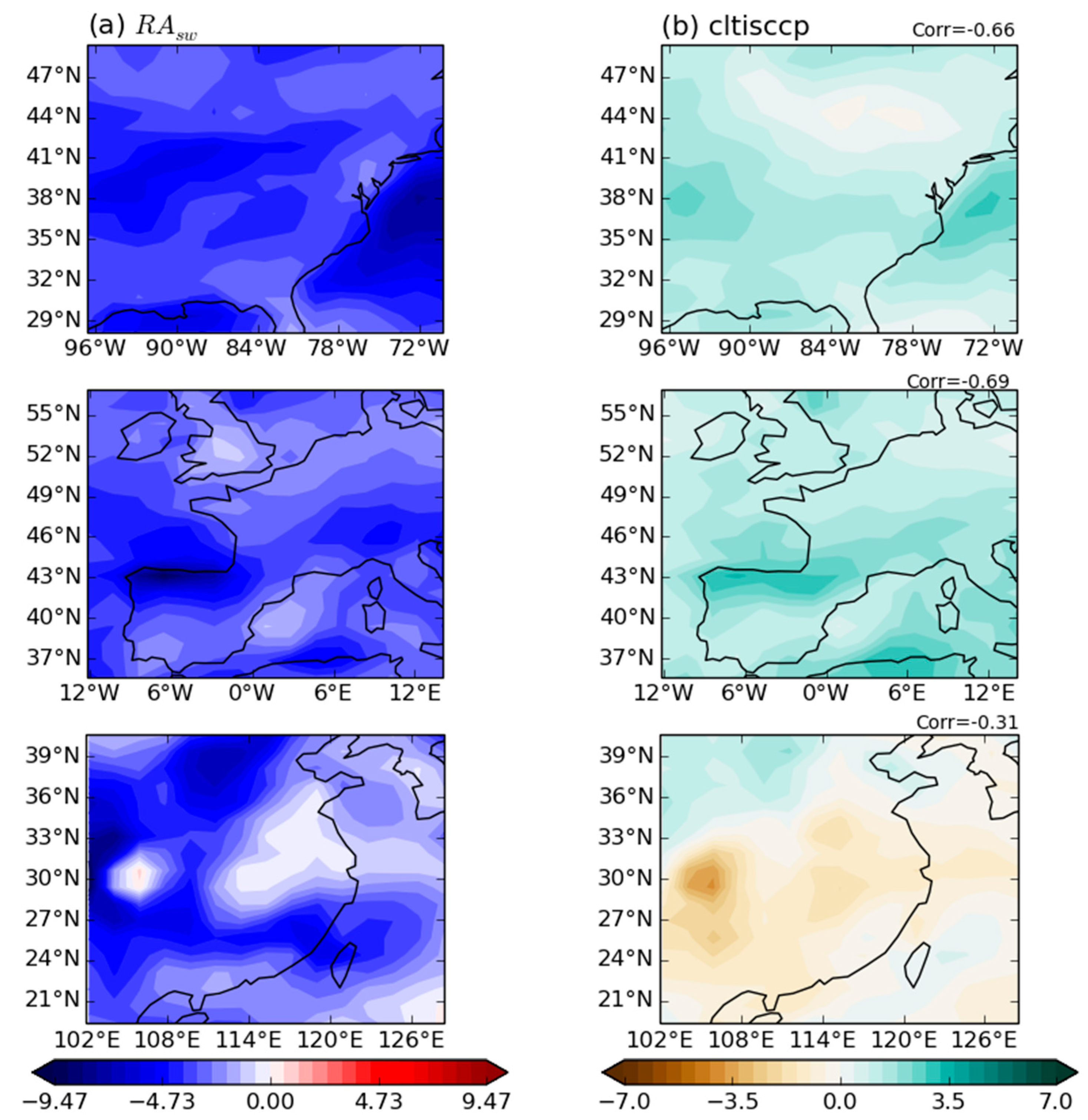The Impacts of Aerosol Emissions on Historical Climate in UKESM1
Abstract
:1. Introduction
2. Experiments
2.1. Model
2.2. Experiments
2.3. ERF
3. Results
3.1. Aerosol Optical Depth
3.2. ERFs
4. Conclusions
Author Contributions
Funding
Conflicts of Interest
References
- Hansen, J.; Sato, M.; Ruedy, R.; Lacis, A.; Oinas, V. Global warming in the twenty-first century: An alternative scenario. Proc. Natl. Acad. Sci. USA 2000, 97, 9875–9880. [Google Scholar] [CrossRef] [PubMed] [Green Version]
- Ramanathan, V.; Crutzen, P.J.; Kiehl, J.T.; Rosenfeld, D. Aerosols, climate, and the hydrological cycle. Science 2001, 294, 2119–2124. [Google Scholar] [CrossRef] [Green Version]
- Dufresne, J.L.; Quaas, J.; Boucher, O.; Denvil, S.; Fairhead, L. Contrast in the effects on climate of anthropogenic sulfate aerosols between the 20th and the 21st century. Geophys. Res. Lett. 2005, 32. [Google Scholar] [CrossRef] [Green Version]
- IPCC. Climate Change 2014: Anthropogenic and Natural Radiative Forcing. In Contribution of Working Group I to the Fifth Assessment Report of the Intergovernmental Panel on Climate Change; Cambridge University Press: Cambridge, UK; New York, NY, USA, 2014; pp. 659–740. [Google Scholar]
- Feichter, J.; Roeckner, E.; Lohmann, U.; Liepert, B. Nonlinear aspects of the climate response to greenhouse gas and aerosol forcing. J. Clim. 2004, 17, 2384–2398. [Google Scholar] [CrossRef]
- Zhang, H.; Wang, Z.; Wang, Z.; Liu, Q.; Gong, S.; Zhang, X.; Shen, Z.; Lu, P.; Wei, X.; Che, H.; et al. Simulation of direct radiative forcing of aerosols and their effects on East Asian climate using an interactive AGCM-aerosol coupled system. Clim. Dyn. 2012, 38, 1675–1693. [Google Scholar] [CrossRef]
- Shim, S.; Kim, J.; Yum, S.S.; Lee, H.; Boo, K.-O.; Byun, Y.-H. Effects of anthropogenic and natural forcings on the summer temperature variations in east Asia during the 20th century. Atmosphere 2019, 10, 690. [Google Scholar] [CrossRef] [Green Version]
- Lohmann, U.; Feichter, J.; Penner, J.; Leaitch, R. Indirect effect of sulfate and carbonaceous aerosols: A mechanistic treatment. J. Geophys. Res. 2000, 105, 12193–12206. [Google Scholar] [CrossRef]
- Jones, A.; Roberts, D.L.; Woodage, M.J.; Johnson, C.E. Indirect sulphate aerosol forcing in a climate model with an interactive sulphur cycle. J. Geophys. Res. 2001, 106, 20293–20310. [Google Scholar] [CrossRef] [Green Version]
- Denman, K.L.; Brasseur, G. Couplings between Changes in the Climate System and Biogeochemistry. In Climate Change 2007: The Physical Science Basis; Solomon, S., Qin, D., Manning, M., Chen, Z., Marquis, M., Averyt, K.B., Tigor, M., Miller, H.L., Eds.; Cambridge University Press: Cambridge, UK, 2007; pp. 129–234. [Google Scholar]
- Mitchell, J.; Johns, T.; Gregory, J.; Tett, S. Climate response to increasing levels of greenhouse gases and sulfate aerosols. Nature 1995, 376, 501–504. [Google Scholar] [CrossRef]
- Menon, S.; Hansen, J.; Nazarenko, L.; Luo, Y. Climate effects of black carbon aerosols in China and India. Science 2002, 297, 2250–2253. [Google Scholar] [CrossRef] [Green Version]
- Wang, Z.; Zhang, H.; Lu, P. Improvement of cloud microphysics in the aerosol-climate model BCC_AGCM2.0.1_CUACE/Aero, evaluation against observations, and updated aerosol indirect effect. J. Geophys. Res. Atmos. 2014, 119, 8400–8417. [Google Scholar] [CrossRef]
- Bond, T.C.; Doherty, S.J.; Fahey, D.W.; Forster, P.M.; Berntsen, T.; DeAngelo, B.J.; Flanner, M.G.; Ghan, S.; Kärcher, B.; Koch, D.; et al. Bounding the role of black carbon in the climate system: A scientific assessment. J. Geophys. Res. 2013, 118, 5380–5552. [Google Scholar] [CrossRef]
- Boucher, O.; Randall, D.; Artaxo, P.; Bretherton, C.; Feingold, G.; Forster, P.; Kerminen, V.M.; Kondo, Y.; Liao, H.; Lohmann, U.; et al. Contribution of Working Group to the Fifth Assessment Report of the Intergovernmental Panel on Climate Change. Clouds and Aerosols. In Climate Change 2013: The Physical Science Basis; Stocker, T.F., Qin, D., Plattner, G.K., Tignor, M., Allen, S.K., Doschung, J., Nauels, A., Xia, Y., Bex, V., Midgley, P.M., Eds.; Cambridge University Press: Cambridge, UK; New York, NY, USA, 2013; pp. 616–617. [Google Scholar]
- Bowerman, N.H.A.; Frame, D.J.; Huntingford, C.; Lowe, J.A.; Smith, S.M.; Allen, M.R. The role of short-lived climate pollutants in meeting temperature goals. Nat. Clim. Chang. 2013, 3, 1021–1024. [Google Scholar] [CrossRef]
- Smith, S.J.; Bond, T.C. Two hundred fifty years of aerosols and climate: The end of the age of aerosols. Atmos. Chem. Phys. 2014, 14, 537–549. [Google Scholar] [CrossRef] [Green Version]
- Hansen, J.; Ruedy, R.; Sato, M.; Imhoff, M.; Lawrence, W.; Easterling, D.; Peterson, T.; Karl, T. A closer look at United States and global surface temperature change. J. Geophys. Res. Space Phys. 2001, 106, 23947–23963. [Google Scholar] [CrossRef] [Green Version]
- Philipona, R.; Behrens, K.; Ruckstuhl, C. How declining aerosols and rising greenhouse gases forced rapid warming in Europe since 1980s. Geophys. Res. Lett. 2009, 36, L02806. [Google Scholar] [CrossRef] [Green Version]
- Quaas, J.; Boucher, O. Constraining the first aerosol indirect radiative forcing in the LMDZ GCM using POLDER and MODIS satelliete data. Geophys. Res. Lett. 2005, 32, L17814. [Google Scholar] [CrossRef] [Green Version]
- Giorgi, F.; Bi, X.; Qian, Y. Direct radiative forcing and regional climatic effects of anthropogenic aerosols over East Asia: A regional coupled climate-chemistry/aerosol model study. J. Geophy. Res. 2002, 107, D204439. [Google Scholar] [CrossRef]
- Ramer, L.A.; Kleidman, R.G.; Levy, R.C.; Kaufman, Y.J.; Tanre, D.; Mattoo, S.; Martins, J.V.; Ichobk, C.; Koren, I.; Yu, H.; et al. Global aerosol climatology from the MODIS satellite sensors. J. Geophys. Res. 2008, 113, D14S07. [Google Scholar] [CrossRef] [Green Version]
- Hansen, J.; Sato, M.; Ruedy, R. Radiative forcing and climate response. J. Geophys. Res. 1997, 102, 6831–6864. [Google Scholar] [CrossRef]
- Shine, K.P. The effects of human activity on radiative forcing of climate change: A review of recent developments. Glob. Planet Chang. 1999, 20, 205–225. [Google Scholar]
- Myhre, G.; Samset, B.H.; Schulz, M.; Balkanski, Y.; Bauer, S.; Berntsen, T.K.; Bian, H.; Bellouin, N.; Chin, M.; Diehl, T.; et al. Radiative forcing of the direct aerosol effect from AeroCom Phase II simulations. Atmos. Chem. Phys. 2013, 13, 1853–1877. [Google Scholar]
- Sherwood, S.C.; Bony, S.; Boucher, O.; Bretherton, C.; Forster, P.M.; Gregory, J.M.; Stevens, B. Adjustments in the forcing–feedback framework for understanding climate change. Bull. Am. Meteorol. Soc. 2015, 96, 217–228. [Google Scholar]
- Forster, P.M.; Richardson, T.; Maycock, A.C.; Smith, C.J.; Samset, B.H.; Myhre, G.; Andrews, T.; Pincus, R.; Schulz, M. Recommendations for diagnosing effective radiative forcing from climate models for CMIP6. J. Geophys. Res. Atmos. 2016, 121, 12–460. [Google Scholar]
- Collins, W.; Lamarque, J.-F.; Schulz, M.; Boucher, O.; Eyring, V.; Hegglin, M.I.; Maycock, A.C.; Myhre, G.; Prather, M.J.; Shindell, D.; et al. AerChemMIP: Quantifying the effects of chemistry and aerosols in CMIP6. Geosci. Model Dev. 2017, 10, 585–607. [Google Scholar]
- Walters, D.; Baran, A.J.; Boutle, I.A.; Brooks, M.; Earnshaw, P.; Edwards, J.; Furtado, K.; Hill, P.; Lock, A.; Manners, J.; et al. The Met Office Unified Model Global Atmosphere 7.0/7.1 and JULES Global Land 7.0 configurations. Geosci. Model Dev. 2019, 12, 1909–1963. [Google Scholar]
- Hewitt, H.T.; Copsey, D.; Culverwell, I.D.; Harris, C.M.; Hill, R.S.R.; Keen, A.B.; McLaren, A.J.; Hunke, E.C. Design and implementation of the infrastructure of HadGEM3: The next-generation Met Office climate modelling system. Geosci. Model Dev. 2011, 4, 223–253. [Google Scholar]
- Archibald, A.T.; O’Connor, F.M.; Abraham, N.L.; Archer-Nicholls, S.; Chipperfield, M.P.; Dalvi, M.; Folberth, G.A.; Dennison, F.; Dhomse, S.S.; Griffiths, P.T.; et al. Description and evaluation of the UKCA stratosphere-troposphere chemistry scheme (StratTrop vn 1.0) implemented in UKESM1. Geosci. Model Dev. 2019, 13, 1223–1266. [Google Scholar]
- Morgenstern, O.; Braesicke, P.; O’Connor, F.M.; Bushell, A.C.; Johnson, C.E.; Osprey, S.M.; Pyle, J.A. Evaluation of the new UKCA climate-composition model—Part 1: The stratosphere. Geosci. Model Dev. 2009, 2, 43–57. [Google Scholar]
- O’Connor, F.M.; Johnson, C.E.; Morgenstern, O.; Abraham, N.L.; Braesicke, P.; Dalvi, M.; Folberth, G.A.; Sanderson, M.G.; Telford, P.J.; Voulgarakis, A.; et al. Evaluation of the new UKCA climate composition model. Part II. The troposphere. Geosci. Model Dev. 2014, 7, 41–91. [Google Scholar]
- Mann, G.W.; Carslaw, K.S.; Spracklen, D.V.; Ridley, D.A.; Manktelow, P.T.; Chipperfield, M.P.; Pickering, S.J.; Johnson, C.E. Description and evaluation of GLOMAP-mode: A modal global aerosol microphysics model for the UKCA composition-climate model. Geosci. Model Dev. 2010, 3, 519–551. [Google Scholar]
- Mulcahy, J.P.; Johnson, C.; Jones, C.; Povey, A.; Sellar, A.; Scott, C.E.; Turnock, S.T.; Woodhouse, M.T.; Abraham, L.N.; Andrews, M.; et al. Description and evaluation of aerosol in UKESM1 and HadGEM3-GC3.1 CMIP6 historical simulations. Geosci. Model Dev. 2019. [Google Scholar] [CrossRef]
- Sellar, A.; Jones, C.G.; Mulcahy, J.P.; Tang, Y.; Yool, A.; Wiltshire, A.; O’Connor, F.M.; Stringer, M.; Hill, R.; Palmieri, J.; et al. UKESM1: Description and Evaluation of the U.K. Earth System Model. J. Adv. Model Earth Syst. 2019, 11, 4513–4558. [Google Scholar]
- Smith, C.J.; Kramer, R.J.; Myhre, G.; Alterskjær, K.; Collins, W.; Sima, A.; Boucher, O.; Dufresne, J.-L.; Nabat, P.; Michou, M.; et al. Effective radiative forcing and adjustments in CMIP6 models. Atmos. Chem. Phys. Discuss. 2020, 20, 9591–9618. [Google Scholar]
- Thornhill, G.D.; Collins, W.J.; Kramer, R.J.; Olivié, D.; O’Connor, F.; Abraham, N.L.; Bauer, S.E.; Deushi, M.; Emmons, L.; Forster, P.; et al. Effective Radiative forcing from emissions of reactive gases and aerosols—A multimodel comparison. Atmos. Chem. Phys. Discuss. 2020. [Google Scholar] [CrossRef] [Green Version]
- Eyring, V.; Bony, S.; Meehl, G.A.; Senior, C.A.; Stevens, B.; Stouffer, R.J.; Taylor, K.E. Overview of the Coupled Model Intercomparison Project Phase 6 (CMIP6) experimental design and organization. Geosci. Model Dev. 2016, 9, 1937–1958. [Google Scholar] [CrossRef] [Green Version]
- Hoesly, R.M.; Smith, S.J.; Feng, L.; Klimont, Z.; Janssens-Maenhout, G.; Pitkanen, T.; Seibert, J.J.; Vu, L.; Andres, R.J.; Bolt, R.M.; et al. Historical (1750–2014) anthropogenic emissions of reactive gases and aerosols from the Community Emission Data System (CEDS). Geosci. Model Dev. 2017, 11, 369–408. [Google Scholar]
- Van Marle, M.J.E.; Kloster, S.; Magi, B.; Marlon, J.R.; Daniau, A.-L.; Field, R.D.; Arneth, A.; Forrest, M.; Hantson, S.; Kehrwald, N.M.; et al. Historic global biomass burning emissions for CMIP6 (BB4CMIP) based on merging satellite observations with proxies and fire models (1750–2015). Geosci. Model Dev. 2017, 10, 3329–3357. [Google Scholar]
- Meinshausen, M.; Vogel, E.; Nauels, A.; Lorbacher, K.; Meinshausen, N.; Etheridge, D.M.; Fraser, P.J.; Montzka, S.A.; Rayner, P.; Trudinger, C.M.; et al. Historical greenhouse gas concentrations for climate modelling (CMIP6). Geosci. Model Dev. 2017, 10, 2057–2116. [Google Scholar] [CrossRef] [Green Version]
- Ghan, S.J. Technical note: Estimating aerosol effects on cloud radiative forcing. Atmos. Chem. Phys. 2013, 13, 9971–9974. [Google Scholar]
- Zelinka, M.D.; Andrews, T.; Forster, P.M.; Taylor, K.E. Quantifying components of aerosol-cloud-radiation interactions in climate models. J. Geophys. Res. Atmos. 2014, 119, 7599–7615. [Google Scholar] [CrossRef] [Green Version]
- O’Connor, F.M.; Abraham, N.L.; Dalvi, M.; Folberth, G.A.; Griffiths, P.T.; Hardacre, C.; Johnson, B.T.; Kahana, R.; Keeble, J.; Kim, B.; et al. Assessment of pre-industrial to present-day anthropogenic climate forcing in UKESM1. Atmos. Chem. Phys. 2020, 1–49. [Google Scholar] [CrossRef] [Green Version]
- Yu, R.; Wang, B.; Zhou, T. Climate Effects of the Deep Continental Stratus Clouds Generated by the Tibetan Plateau. J. Clim. 2004, 17, 2702–2713. [Google Scholar] [CrossRef] [Green Version]
- Philander, S.G.H.; Gu, D.; Lambert, G.; Li, T.; Halpern, D.; Lau, N.-C.; Pacanowski, R.C. Why the ITCZ Is Mostly North of the Equator. J. Clim. 1996, 9, 2958–2972. [Google Scholar] [CrossRef] [Green Version]
- Yu, J.-Y.; Mechoso, C.R. Links between Annual Variations of Peruvian Stratocumulus Clouds and of SST in the Eastern Equatorial Pacific. J. Clim. 1999, 12, 3305–3318. [Google Scholar] [CrossRef]
- Wang, Y.; Jiang, J.H.; Su, H. Atmospheric responses to the redistribution of anthropogenic aerosols. J. Geophys. Res. Atmos. 2015, 120, 9625–9641. [Google Scholar] [CrossRef]







| Experiment ID | MIP | N2O | CH4 | Aerosol Precursors | Trop. O3 Precursors |
|---|---|---|---|---|---|
| histSST | AerChemMIP | Hist | Hist | Hist | Hist |
| histSST-piAer | AerChemMIP | Hist | Hist | 1850 | Hist |
| piClim-control | CMIP6 | 1850 | 1850 | 1850 | 1850 |
| piClim-Aer | AerChemMIP | 1850 | 1850 | 2014 | 1850 |
| piClim-SO2 | AerChemMIP | 1850 | 1850 | 1850 (non-SO2) 2014 (SO2) | 1850 |
| piClim-BC | AerChemMIP | 1850 | 1850 | 1850 (non-BC) 2014 (BC) | 1850 |
| piClim-OC | AerChemMIP | 1850 | 1850 | 1850 (non-OC) 2014 (OC) | 1850 |
| sstClim | CMIP5 | 1850 | 1850 | 1850 | 1850 |
| sstClimAerosol | CMIP5 | 1850 | 1850 | 2000 | 1850 |
| RF Relative to PI | Glob | EUS | WEU | ECC | ||
|---|---|---|---|---|---|---|
| T1 | ERF | −1.03 ± 0.05 | −5.04 ± 0.27 | −2.89 ± 0.37 | −2.34 ± 0.34 | |
| IRF | −0.16 ± 0.01 | −1.44 ± 0.09 | −0.92 ± 0.08 | 0.10 ± 0.04 | ||
| RA | 0.00 ± 0.02 | −0.46 ± 0.19 | 0.37 ± 0.15 | 0.08 ± 0.22 | ||
| −0.87 ± 0.04 | −3.14 ± 0.27 | −2.34 ± 0.40 | −2.52 ± 0.41 | |||
| T2 | ERF | −1.43 ± 0.05 | −4.57 ± 0.32 | −3.23 ± 0.38 | −3.87 ± 0.32 | |
| IRF | −0.30 ± 0.01 | −1.63 ± 0.06 | −1.23 ± 0.09 | −0.74 ± 0.08 | ||
| RA | 0.04 ± 0.03 | −0.00 ± 0.23 | 0.45 ± 0.17 | 0.12 ± 0.18 | ||
| −1.17 ± 0.03 | −2.94 ± 0.30 | −2.45 ± 0.40 | −3.24 ± 0.32 | |||
Publisher’s Note: MDPI stays neutral with regard to jurisdictional claims in published maps and institutional affiliations. |
© 2020 by the authors. Licensee MDPI, Basel, Switzerland. This article is an open access article distributed under the terms and conditions of the Creative Commons Attribution (CC BY) license (http://creativecommons.org/licenses/by/4.0/).
Share and Cite
Seo, J.; Shim, S.; Kwon, S.-H.; Boo, K.-O.; Kim, Y.-H.; O’Connor, F.; Johnson, B.; Dalvi, M.; Folberth, G.; Teixeira, J.; et al. The Impacts of Aerosol Emissions on Historical Climate in UKESM1. Atmosphere 2020, 11, 1095. https://doi.org/10.3390/atmos11101095
Seo J, Shim S, Kwon S-H, Boo K-O, Kim Y-H, O’Connor F, Johnson B, Dalvi M, Folberth G, Teixeira J, et al. The Impacts of Aerosol Emissions on Historical Climate in UKESM1. Atmosphere. 2020; 11(10):1095. https://doi.org/10.3390/atmos11101095
Chicago/Turabian StyleSeo, Jeongbyn, Sungbo Shim, Sang-Hoon Kwon, Kyung-On Boo, Yeon-Hee Kim, Fiona O’Connor, Ben Johnson, Mohit Dalvi, Gerd Folberth, Joao Teixeira, and et al. 2020. "The Impacts of Aerosol Emissions on Historical Climate in UKESM1" Atmosphere 11, no. 10: 1095. https://doi.org/10.3390/atmos11101095





